 Security personnel patrol during a lockdown in Srinagar on August 10 | AFP
Security personnel patrol during a lockdown in Srinagar on August 10 | AFP
On Sunday, Reuters reported that security forces used tear gas and pellet guns to disperse around 10,000 protesters in Srinagar, who were demonstrating against the withdrawal of special rights for Jammu and Kashmir. The crowd was pushed back by police at Aiwa bridge, where a witness said tear gas and pellets were used against them, reported the agency. "Some women and children even jumped into the water," a witness said at Srinagar's Sher-e-Kashmir Institute of Medical Sciences, where pellet victims were admitted, claimed Reuters. "They (police) attacked us from two sides," another witness told them.
The spokesperson for the ministry of home affairs, Vasudha Gupta, tweeted a rebuttal, taking Reuters and the Pakistani publication Dawn by name. “A news report originally published in Reuters and appeared in Dawn claims there was a protest involving 10,000 people in Srinagar. This is completely fabricated and incorrect. There have been a few stray protests in Srinagar/Baramulla and none involved a crowd of more than 20 ppl,” the spokesperson tweeted.
A news report originally published in Reuters and appeared in Dawn claims there was a protest involving 10000 people in Srinagar.
This is completely fabricated & incorrect. There have been a few stray protests in Srinagar/Baramulla and none involved a crowd of more than 20 ppl.
3,749 people are talking about this
Ever since the decision by the Union government to abrogate Article 370, which granted special rights to the Jammu and Kashmir, and bifurcate the state, life had turned upside down for the ordinary Kashmiris. Completely cut off from all modes of communication, and under strict curfews, resentment was on the rise, as reported by several news agencies. "This is no more about PDP, NC or Hurriyat. This is about Kashmir, Kashmiriyat and Muslim majority character of the place. We have to be united to defeat the designs of the BJP of changing the demography of the valley," Aijaz Bhat, a businessman, told PTI. He said the move to divide the state into two Union territories and removing provisions of Article 370 was tantamount to "backstabbing and treachery".
While the tourists and Amarnath pilgrims were evacuated by the government last week, thousands of migrant labourers who come to the valley to earn their livelihood are finding difficult to get back to their homes, reported PTI. "The locals have been nice to us but there is no point staying back in Kashmir if we cannot find work. The valley has been put under siege and we do not see any hope of normalcy returning anytime soon," Govind Kumar, a labourer from Bihar, said. "The security personnel are not allowing us to even go out for collecting our dues. We have to make early morning walks to our clients' homes for it now. Hopefully, we shall be leaving in a day or two," he added.
But, what is actually happening on the ground? Dearth of of ground reports, followed by alleged muzzling of local media—Anuradha Bhasin, the editor of Kashmir Times, moved the Supreme Court seeking action against shutdown of communications and curbs on movement of journalists—has further queered up the pitch. The Editors' Guild of India expressed deep concerns over the continued shutdown in communication links with Kashmir and the consequent curtailment of the media's freedom and ability to report fairly and accurately on current developments. “While some visiting journalists may be able to file their reports once they are out of the valley, the lockdown is almost total and draconian for the vibrant local media that are the first eyes and ears on the ground. The government knows very well that it is impossible to process and publish news now without the internet. It owes it to the people of India, including all in the state of Jammu and Kashmir, to allow the press, a vital institution of democracy, to function freely,” according to the statement.
1,249 people are talking about this
CPI(M) general secretary Sitaram Yechury and CPI chief D. Raja said they were prevented from entering the state."We were in judicial and police custody. They had an order in my name which they showed me and said that we had to go back by the same flight we came on. We refused and sat there for four hours. We had given them prior information about our visit. There was no reason to detain us. The real truth of Jammu and Kashmir is not out. If all is well, then why were we stopped?" asked Yechury.
All these had made it easier for vastly divergent narratives to take root. “I have received confirmed reports of over 250 casualties of civilians clashing with Indian security forces in Kashmir,” tweeted Pakistani analyst Zaid Hamid. “Just one hospital in Srinagar has recieved 50 bodies so far.... I have also seen around 14 dead bodies of Indian troops killed in the violent clashes.”
The same was debunked by Imtiyaz Hussain, a Jammu and Kashmir police officer.
I pity the wisdom of people who believe this joker. twitter.com/zaidzamanhamid…
6,259 people are talking about this
The BBC reported that thousands of people took to the streets in Srinagar after Friday prayers, in the largest demonstration since a lockdown was imposed in Kashmir. “The BBC witnessed the police opening fire and using tear gas to disperse the crowd. Despite that, the Indian government has said the protest never took place,” the publication wrote. BBC South Asia bureaux chief Nicola Careem tweeted a video purportedly showing security forces firing at protesters.
18.2K people are talking about this
Al Jazeera claimed that the security forces used pellet guns, citing the case of 16-year-old Asrar Khan, who, according to the report, was hit by tear gas shells and pellet gun shrapnel, and was admitted in critical condition at the Shere Kashmir Institute of Medical Science (SKIMS).
Congress president Rahul Gandhi tore into the Centre. “Some reports have come in from Jammu and Kashmir about violence there and the Prime Minister Narendra Modi must assuage concerns over the matter in a transparent manner,” he said. "Now it is very important that the government of India and the prime minister make it very clear and transparent on what exactly is happening in the Union Territories of Jammu and Kashmir and Ladakh," he said. "We are extremely concerned about the reports that are coming and the government needs to assuage the country and tell the country what is happening in Jammu and Kashmir," he told reporters.
The Jammu and Kashmir police came out strongly against the statement. "People should not believe any mischievous and motivated news reports regarding firing incidents in the Valley. The police have not fired a single bullet in the last six days. The situation is calm, people are cooperative and restrictions are being relaxed," they said in a statement late on Saturday.
Kashmir Inspector General Swayam Prakash Pani also denied the reports, and claimed that the valley was largely peaceful over the past one week.
The J&K police said the situation was calm, people were cooperative, and restrictions were being relaxed to ease the situation. “Srinagar and other towns were full of traffic and people busy with Eid shopping.”
Jammu&Kashmir:Srinagar City witnessed normal traffic today as people thronged ATMs to collect cash for the upcoming festival.Several shops remained open.
No untoward incident was reported from any district
479 people are talking about this
"Reports of newspapers not being published in Kashmir are wrong," Prasar Bharati News Services tweeted. "English dailies like Greater Kashmir, Rising Kashmir, Kashmir Images and four Urdu dailies are being published from Kashmir."
Reports of newspapers not being published in Kashmir are wrong. English dailies like Greater Kashmir, Rising Kashmir, Kashmir Images and 4 Urdu dailies are being published from Kashmir.
227 people are talking about this
At the same time, continuing his well-broadcast outreach to people of Kashmir, National Security Advisor (NSA) Ajit Doval visited Anantnag and interacted with cattle traders and people ahead of Eid.
National Security Advisor Ajit Doval interacts with shopkeepers at a market in Anantnag, Jammu & Kashmir.
559 people are talking about this
Peaceful observance of Eid al-Adha is on top of the priority list of NSA Ajit Doval, who met Jammu and Kashmir Governor Satyapal Malik on Friday. This healing touch is being put on public display virtually everyday by Doval on the streets of trouble-torn region as he interacts with the locals as part of confidence-building measures begun by the Modi government. The government is also keenly aware that the entire international community is watching how the government treats the minority community.




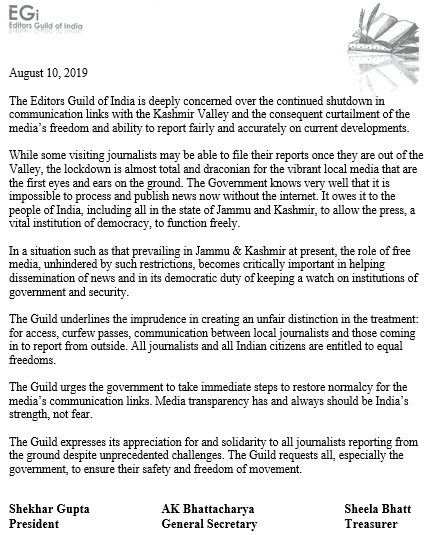


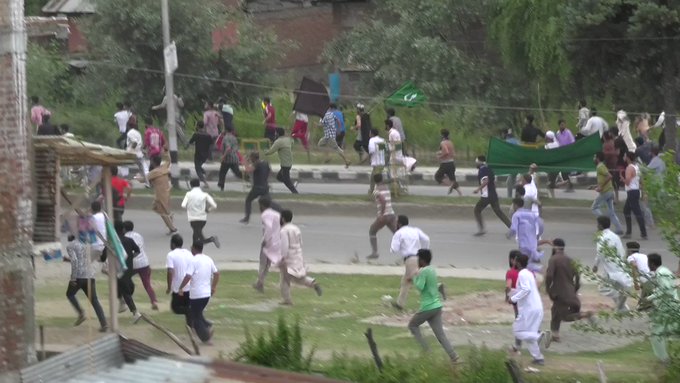

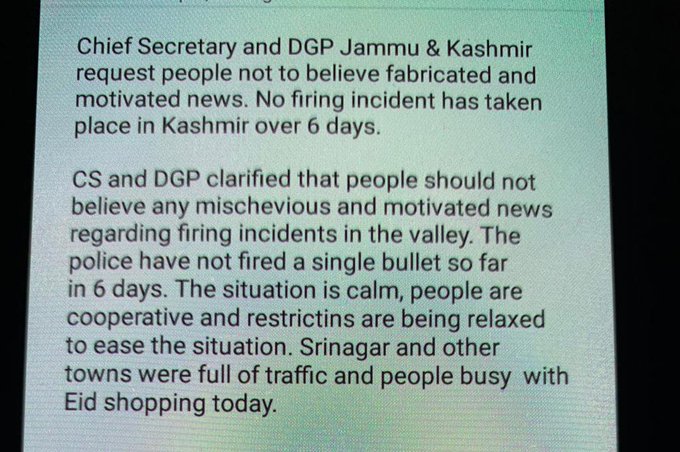

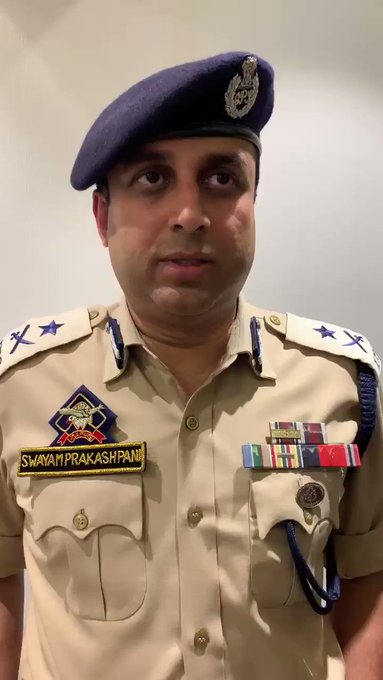

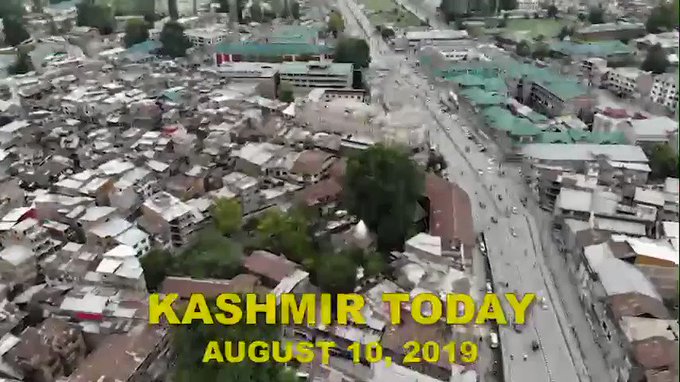

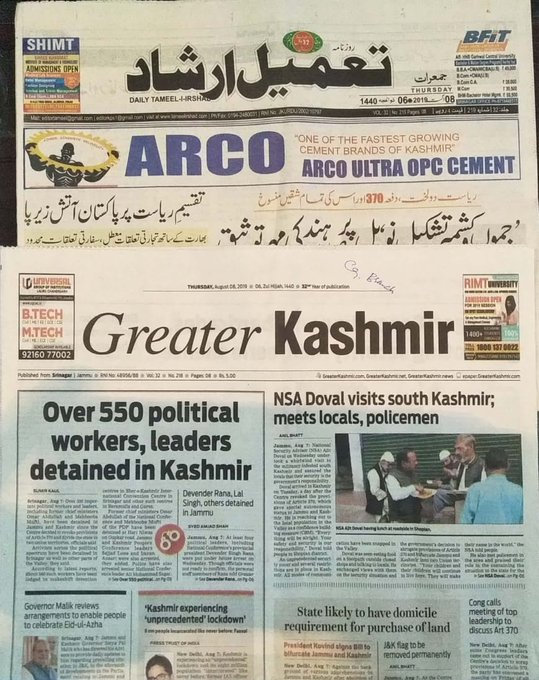
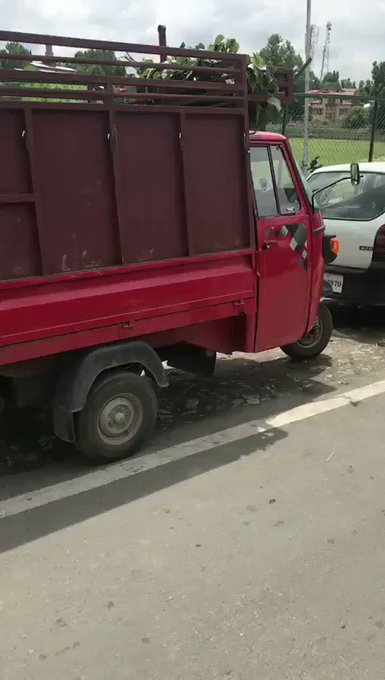



No comments:
Post a Comment